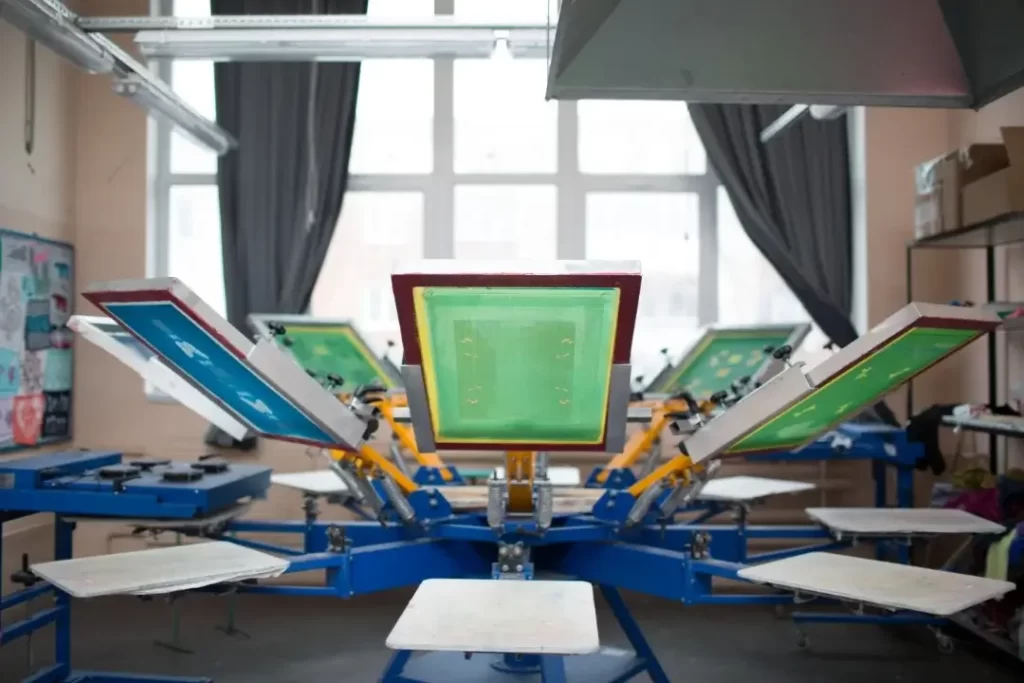
Why Clothing Brands Fail
Top Different Types of Shirts for Women and Men Top Different Types of Shirts for
In the ever-evolving world of fashion and design, staying ahead of the game means making critical decisions – decisions that directly impact the quality and appeal of your finished products. Two key contenders in the battle for printing supremacy are screen printing and heat press printing. Both methods have their ardent advocates, but which one truly reigns supreme?
In this article, we delve into the intricate world of these two popular printing techniques screen printing vs heat press, revealing their unique characteristics and exploring the factors that make them indispensable in the clothing industry. By the end of this captivating journey, you’ll have all the knowledge needed to make an informed decision on the best method for your next project.
So, buckle up and get ready to unravel the mystery that lies at the heart of the screen printing vs heat press printing debate!
Screen printing, also known as silk screening, is a time-honored method that involves pushing ink through a stencil or mesh screen onto the fabric. This technique dates back thousands of years and has been refined over time to create intricate, high-quality designs that are both eye-catching and durable.

Durability: One of the primary reasons screen printing remains a popular choice is its durability. The ink bonds tightly with the fabric, resulting in prints that can withstand countless washes without fading or cracking.
Vibrant Colors: Screen printing is renowned for producing vivid, bold colors that stand out from the crowd. This method allows for exceptional color saturation, ensuring your designs make a lasting impression.
Long-lasting Prints: The combination of durability and vibrant colors makes screen-printed garments a favorite among businesses and individuals alike. With proper care, these prints will maintain their original appearance for years to come.
High Setup Costs: Screen printing requires a substantial investment upfront, particularly when creating custom screens for each design. This factor can make it less cost-effective for small-scale projects or designs with multiple colors.
Limited Color Options: While screen printing delivers exceptional results for designs with few colors, it can be challenging to reproduce intricate, multicolored designs accurately. Each color must be applied separately, and the process can become time-consuming and expensive for complex patterns.
Less Eco-friendly: The screen printing process typically uses plastisol inks, which are not as environmentally friendly as water-based inks. In addition, the process generates more waste compared to other printing methods, such as heat-press printing.
Despite these disadvantages, screen printing remains a popular choice for many businesses and individuals seeking high-quality, durable prints. In the next section, we’ll explore the world of heat-press t-shirt printing and see how it compares to screen printing.
The heat press is a modern method that utilizes heat and pressure to transfer a design onto fabric. This process typically involves the use of transfer paper, which carries the design and is applied to the garment using a heat press machine. Learn more about heat press printing.

The heat-press printing process consists of several steps:
Design creation: The design is either digitally printed or cut from vinyl material.
Transfer preparation: The design is then placed on transfer paper or vinyl.
Heat application: The transfer paper or vinyl is positioned on the fabric, and the heat press machine applies consistent heat and pressure to transfer the design onto the garment.
Clamshell: A clamshell heat press features a hinge between the top and bottom plates, making it easy to open and close like a clamshell. This design is popular for its space-saving and user-friendly nature.
Swing-away: The swing-away heat press allows the top plate to swing away from the bottom plate, providing more workspace and easier access to the garment. This design is ideal for more intricate projects.
Draw-style: With a draw-style heat press, the bottom plate slides out like a drawer, providing a more convenient working area. This type is perfect for those who need precision in their designs.
Vinyl: Vinyl heat presses specifically use vinyl material for the designs. This type allows for a wider range of colors and intricate patterns, making it popular among businesses and individuals alike.
Affordability: Heat press offers a more affordable alternative to screen printing, particularly for smaller projects or those with multiple colors.
Easy to Use: Heat press machines are relatively simple to operate, making them an attractive option for beginners or those with limited experience in garment printing.
High-Quality Prints: Despite its lower cost, heat press can still deliver crisp, high-quality designs that rival those produced by screen printing.
Limited Durability: While heat press prints can be high-quality, they may not have the same durability as screen-printed designs, especially when exposed to repeated washing.
Limited to Certain Fabrics: Heat press-printing works best with polyester and other heat-resistant materials for heat press t-shirt printing, making it less suitable for some fabrics, such as delicate or heat-sensitive materials.
Limited Color Options: Although screen printing vs vinyl heat press offers more color options, traditional heat press may not reproduce intricate, multicolored designs as accurately as screen printing.
Despite its limitations, the heat press remains an attractive option for many businesses and individuals seeking an affordable, user-friendly method for garment printing. The choice between screen printing and heat-press printing ultimately depends on factors such as project size, budget, and design complexity.
Screen printing tends to have higher setup costs, making it more expensive for small-scale projects or those with multiple colors. On the other hand, screen printing vs heat press, heat press printing offers a more affordable alternative, particularly for short runs or designs with numerous colors.
Both screen and heat press printing can produce high-quality prints, but there are subtle differences in the results. Screen printing is known for its vibrant, bold colors and excellent color saturation, while heatpress delivers crisp, detailed designs that can rival those produced by screen printing. However, heat press may not have the same level of color vibrancy as screen printing.
Screen printing can produce exceptional results for designs with few colors but may struggle to reproduce intricate, multicolored designs accurately. In contrast, vinyl heat press printing offers more color options and can handle more complex patterns, while traditional heat press printing may not reproduce multicolored designs as accurately as screen printing.
Screen printing is known for its long-lasting, durable prints that can withstand countless washes without fading or cracking. Heat press prints, on the other hand, may not have the same level of durability as screen-printed designs, particularly when exposed to repeated washing.
Screen printing can be a time-consuming process, especially for designs with multiple colors, as each color must be applied separately. Additionally, the setup process for screen printing is more labor-intensive. Heat press, in comparison, is generally faster and more efficient, particularly for small-scale projects or those with numerous colors.
Before deciding on a printing method, it’s crucial to evaluate several factors that can influence the final outcome. By considering these elements, you can make an informed decision that best suits your project’s needs.
For large-scale projects or high-volume orders, screen printing is often the more cost-effective option, as the setup costs can be spread over numerous items. However, for smaller runs or one-off designs, heat press printing may be the more budget-friendly choice.
Intricate, multicolored designs may be better suited for heat press, particularly vinyl heat-press printing. On the other hand, screen printing excels at producing vivid, bold colors for designs with few colors.
Screen printing works well on various fabric types, while heat press is more limited and works best with polyester and other heat-resistant materials. If your project involves delicate or heat-sensitive fabrics, screen printing may be the better option.
If cost is a major concern, a heat press generally offers a more affordable alternative to screen printing, especially for small-scale projects or those with multiple colors.
Heat press printing is typically faster and more efficient than screen printing heat press, which can be a significant advantage for projects with tight deadlines or when quick turnaround times are crucial.
Ultimately, the decision between heat press vs screen print depends on the unique requirements of your project. Screen printing is the go-to choice for large-scale projects, designs with few colors, and those seeking the highest level of durability. On the other hand, the heat press is an attractive alternative for smaller projects, designs with numerous colors, or those looking for a more affordable and efficient printing method.
By carefully evaluating factors for heat press vs screen printing, such as quantity, design complexity, fabric type, budget, and production time, you can make an informed decision knowing is screen printing or heat press better? That leads to the creation of exceptional garments that meet your specific needs. The key lies in understanding the advantages and limitations of each method and choosing the one that aligns best with your project’s requirements.
Heat-press printing is generally more cost-effective for small projects.
Screen printing is known for its durability and long-lasting prints.
Heat-press, particularly vinyl heat-press printing, is better suited for complex, multicolored designs.
Heat press printing is generally considered more eco-friendly than screen printing, which often uses plastisol inks.
Heat press printing works best with polyester and heat-resistant materials, making it less suitable for some fabrics.
Heat-press is generally faster and more efficient than screen printing.
Screen printing may struggle to reproduce intricate, multicolored designs as accurately as heat-press printing.
The heat press is relatively simple to operate, making it an attractive option for beginners.
Yes, there are various types of heat press machines, including clamshell, swing-away, draw-style, and vinyl heat presses.
Screen printing is often more cost-effective for high-volume orders due to the lower cost per item when setup costs are spread over numerous items.
No, screen printing and heat press printing are two separate methods. Screen printing involves pushing ink through a stencil or mesh screen onto the fabric, while heat press printing uses heat and pressure to transfer a design from transfer paper or vinyl onto the fabric.
Expert Custom Clothing Manufcaturer

Top Different Types of Shirts for Women and Men Top Different Types of Shirts for

What You Must Know About Clothing Samples? Before You Produce a Single Garment: What You

How Much Does It Cost To Make a Hoodie A Complete Cost Breakdown for Custom

Discover the Types of Buttons Discover the Types of Buttons That Transform Style and Functionality
Most Recent Posts
Expert Custom Clothing Manufcaturer
Join our Mailing list!
Get all latest news, exclusive deals and updates.